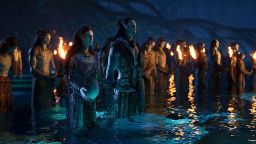Editor’s Note: Jeff Yang is a research director for the Institute for the Future and the head of their Digital Intelligence Lab. A frequent contributor to CNN Opinion, he co-hosts the podcast “They Call Us Bruce,” and is co-author of the book “RISE: A Pop History of Asian America from the Nineties to Now.” The opinions expressed in this commentary are his. Read more opinion on CNN.
In the runup to the release of “Avatar: The Way of Water,” director James Cameron slapped back at critics and viewers who’d expressed doubts about the franchise’s continued relevance: “The trolls will have it that nobody gives a sh*t and they can’t remember the characters’ names or one damn thing that happened in the movie,” he barked to UK movie magazine “Empire.” “Then they see the movie again and go, ‘Oh, okay, excuse me, let me just shut the f**k up right now.’ So I’m not worried about that.”

Well, count me as one of the early skeptics of Cameron’s Pandora enterprise who, after being dragged to “Avatar: The Way of Water” by my 14-year-old son over holiday break, initially felt like I should have shut the f**k up. Though I’d recalled feeling like the 2009 original was more of a weirdly off-putting immersive experience than an actual motion picture, Cameron’s masterful narrative instincts and intricate worldbuilding overwhelmed my reflexive cynicism…for the first half hour of “Way of Water“‘s epic three-hour running length, anyway.
Then I arrived at the moment that reminded me of why I found the first “Avatar” so uncomfortable. Ex-marine Jake Sully (Sam Worthington) — now decanted permanently into his cloned cat-being “avatar” — and his Na’vi spouse Neytiri (Zoe Saldana) realize that they’re putting their people at risk, because Sully’s resurrected nemesis Colonel Quaritch (Stephen Lang), now uploaded into a Na’vi avatar, is intent on hunting him down and more than willing to murder any Na’vi who might stand in his way.
As a result, Sully steps down as war chieftain of the jungle tribe and flees with his family to seek refuge with an ocean clan, the Metkayina. These new Na’vi look different, with semi-amphibious limbs and tails, and have different customs — customs that have been copy-pasted from a range of Pacific Islander traditions, most notably those of the Māori, including the tribe’s social structure, beliefs about hospitality and belonging and even the names of their communal home (marui, almost identical to the Māori word, marae).
They sport distinctive Māori facial and body tattoos. They use a tongue-out, war grimace of defiance when preparing to battle, which the Māori call whetero.
Just as the appearance and traditions of Cameron’s forest Na’vi liberally borrowed from Native American and African peoples, his aqua-Na’vi (naval Na’vi?) are foundationally Polynesian in nature, with key characters played by actors of Māori and other Pacific descent, like Cliff Curtis, who plays Metkayina chief Tonowari, and Duane Evans Jr., who plays a young tribal member named Rotxo.
But extracted from their contexts, pounded into fragments and randomly sifted together, these indigenous “homages” end up serving as mere cultural glitter, giving an authentic-feeling exotic sparkle to Cameron’s synthetic science-fiction milieu. In the process, their original meaning gets erased, as does the lived history of the people who imbued them with that meaning.
And all this comes in service of a story about a White man adopted by a non-White people, who quickly demonstrates that he is superior to the “savages” around him in every way, even their own ways. (In the first film, Sully proves himself worthy of Na’vi respect by taming and riding an Ikran in record time, and he does the same in the second film, quickly bending a vicious flying-fish-like steed known as a Tsurak to his will, earning the reluctant admiration of the Metkayina chief.)

As others have pointed out, tales following this template have come to the big screen countless times, in movies like “Dune” (twice), “The Last Samurai,” “Dances with Wolves,” “The Last of the Mohicans,” “A Man Called Horse” and “Lawrence of Arabia.” More frequently than not, these films have been both commercially successful and critically celebrated — the two “Avatar” films included, obviously.
But where the “Avatar” franchise doubles down on these other films is in making its central narrative conceit about White people literally transplanting themselves into non-White bodies, leaving their pale shells behind. In Sully’s case, this allows him to escape his wheelchair-bound human reality to live free and able as a strapping sapphire feline.
Jordan Peele mined the trope of White people dropping their brains into bodies of color in order to become young and fit again effectively for horror in “Get Out.” In “Avatar,” the process is treated as just another plot device, hand-waved away by presenting the avatars in question as mindless lab-grown clones, created from the combined genetic material of Na’vi and their human “drivers.”
While that explanation may provide some comfort for science fiction fans, it doesn’t dodge the fundamental ethical issues related to this body-slaving premise — or the moral ones related to the fact that the “avatar drivers” in the movies are all characters represented as White, while the Na’vi are uniformly represented as non-White (even when played by White actors such as Kate Winslet, Jamie Flatters and Britain Dalton).
All of this isn’t to deny that Cameron has good intentions. The films are emotionally potent attacks on corporate eco-cannibalism. And his choice to cast White actors as the Terran “colonizers” and non-White actors as the noble, oppressed Na’vi was deliberately intended to invoke the real-life circumstances of native peoples, as he said explicitly in legal documents he filed defending the first “Avatar” from accusations of plagiarism (after being sued three times, he won all three cases): “Avatar very pointedly made reference to the colonial period in the Americas, with all its conflict and bloodshed between the military aggressors from Europe and the indigenous peoples. Europe equals Earth. The Native Americans are the Na’vi. It’s not meant to be subtle.”
Yet it’s easy to ask whether Cameron’s science-fiction reinterpretation draws attention to the historical struggles of indigenous people against White Western invasion, or distracts from it. And more than a few indigenous scholars and activists have been asking just that. Yuè Begay, co-chair of Indigenous Pride LA, tweeted a call to boycott the movie, accusing Cameron of appropriating native cultures to satisfy his “savior complex.” Crystal Echo-Hawk, president and CEO of IllumiNative, dismissed the movie as telling a story of colonization “through the lens of a white male,” showing a “level of arrogance once again that a white filmmaker can just somehow tell a story that’s based on Indigenous peoples better than Indigenous peoples ever could.”
Here’s the awkward truth: Cameron is very good at telling stories — indeed, he’s one of the best cinematic storytellers on this planet, and probably any number of other ones still to be discovered. He has command of nearly incalculable resources, and his films reach more people on the planet than virtually any other filmmaker.
Which means that, with two movies out and three yet to come, the tale of Pandora’s occupation is likely already far better known than any stories of the actual genocide, exploitation and cultural decimation of indigenous peoples on Earth, from the Native American Trail of Tears to the brutal putdown of Kenya’s Mau Mau Rebellion to the overthrow and seizure of the Kingdom of Hawaii.
Native educators and leaders like Echo-Hawk have suggested that Cameron should have partnered with native educators and leaders to connect his epic fiction with the tragic facts that inspired it. (Cameron, for his part, acknowledges that he speaks from “a position of white privilege” and pledged to listen to critique rather than push back on it.)
As it is, audiences and critics now and in the future will laud Cameron’s creativity and attention to detail, and they should — but they likely won’t know how much of the franchise’s incredible worldbuilding is simply an act of elaborate collage, snapping together elements pulled from scores of our world’s oldest civilizations, while ascribing them to fantastical cat people rather than resourceful human beings.
Get our free weekly newsletter
- Sign up for CNN Opinion’s newsletter.
- Join us on Twitter and Facebook
And Cameron’s still just getting started. He reportedly intends to introduce at least one new Na’vi tribe, rooted in a different set of human inspirations, in each of his five “Avatar” installments. The next film, with the tentative name of “Avatar 3: The Seed Bearer,” is supposed to include a villainous Na’vi “fire tribe” known as the Ash People, which potentially could be a group that lives in active volcanic terrain. Will their cultural characteristics end up “inspired” by native peoples from lands in the Ring of Fire — Indonesia’s Papuans, or Guatemala’s Mayans, or the Aeta people of the Philippines’ Mount Pinatubo?
With two experiences of backlash under his belt and having made a public vow to “listen” rather than rejecting native criticism, Cameron has some incentive to try something different with the third and subsequent chapters of his greatest epic.
Using some of the uncountabillions Avatar has earned to elevate indigenous voices, histories and stories would be a way for him to tell them, “I see you,” as the Na’vi might say — and redress the harm he has done in jumping into a giant blue body and smashing his way through their cultural landscape, razing their reality even as he tries to save it.







